History of Elm Grove Cemetery
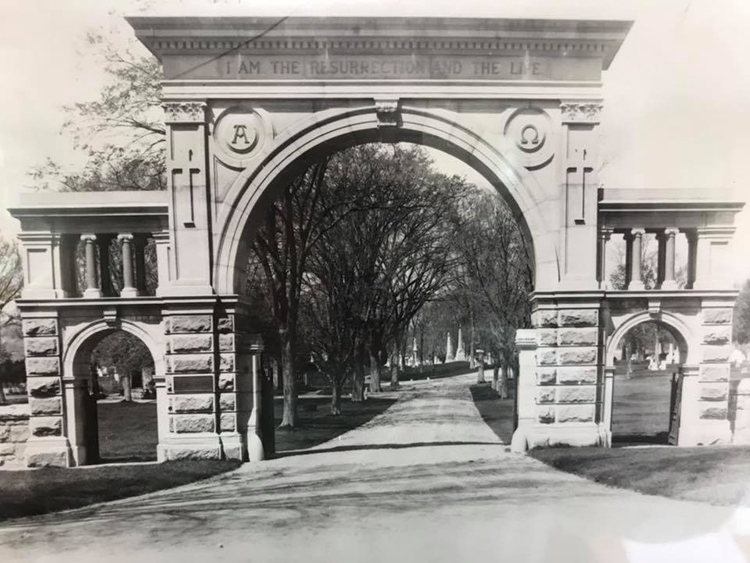
In nineteenth century America, a favorite spot for a Sunday afternoon outing was the local cemetery. Mystic residents spent many leisure time hours strolling among the trees and sepulchers in Elm Grove Cemetery.
The 150+ year-o1d cemetery contains over 13,000 interments and its gravestones read like a Who's Who of Mystic. Hoxie, Grinnell, Greenman, Cottrell, Schofield, Tingley, Spicer, Denison, and Mallory - many of the area's most prominent citizens chose Elm Grove for their final resting place.
Part of the rural cemetery movement of the mid-nineteenth century, Elm Grove represents the Victorian approach to eternal rest - a park setting of rolling hills, brooks, and trees, showcasing ornate sepulchers of Egyptian, Greek and Gothic architecture, decorated with flowers, willow trees, crowns, and trumpeting figures - a stark contrast to the Puritan graveyards of the eighteenth century, whose menacing skulls and crossbones emphasized the finality of death.
The rural cemetery movement began when the American Medical Group suggested that an epidemic of yellow fever that killed 16,000 people in New York City in 1822 was caused by an over-used graveyard near Trinity Church in the heart of the city. Convinced that cemeteries in populated areas posed a health hazard, townspeople began to seek tracts of land outside town limits in which to bury their expanding populations.
The first and most famous of the rural cemeteries was Mt. Auburn, which opened in Cambridge, MA in 1831. Jacob Bigelow, a botanist and member of the Harvard Medical School faculty, established the cemetery under the auspices of the Massachusetts Horticulture Society, planting indigenous and exotic trees and shrubs, while respecting the natural contours of the landscape to establish roads and footpaths to the burial plots. Mt. Auburn became so popular that, within five years, every major city in the U.S. had established a version of Bigelow's design.
By the 1850s, the rural cemetery had become a symbol of a town's wealth and prosperity. The Victorian era was an age of reform, modernization and romanticism. The rural cemetery blended all three, allowing townspeople to show their civic pride by establishing beautiful and expansive burial grounds.
Also called garden cemeteries, this nationwide, cultural movement replaced the overcrowded town and churchyard cites with large privately, owned burial places on the outskirts of town. Influenced by the Victorian view of death as "eternal rest" the term "cemetery" a Greek derivative meaning “to put to sleep," or "a place of rest," quickly replaced “graveyard" and "burial ground" in the American vocabulary.
It was, in 1853, at the height of its maritime activity, that Mystic's citizens met to plan their version of the rural cemetery.
Although Stonington already had over 50 cemeteries, most were small, private, family graveyards, inadequate for the town's growing needs.
The Elm Grove Cemetery Association held its first meeting on January 17, 1853 at the office of Joseph Cottrell. A set of by-laws was adopted establishing the cemetery "for the uses and purposes of a burying ground or place of sepulchers, to enclose with walls, fences, and gates, and grade and layout the same into suitable lots, squares, alleys, walks, etc. and ornaments; and set out the same with shrubbery, trees and plants."
Elected to three-year terms as Elm Grove's first six trustees were banker Elias B. Brown, merchant Joseph Cottrell, and shipbuilders Amos Grinnell, Charles Mallory, George Greenman, and Charles M. Mallory. According to the by-laws, the association would meet annually, the second week in April, to transact business. Anyone owning a lot of 320 sq. ft. was entitled to vote.
The association authorized the trustees to purchase a tract of land between upper and lower Mystic, in Stonington, of neither fewer than 12 nor more than 25 acres, and not to exceed $4,000. Unable to afford their first choice - a tract on White Hall Farm - the trustees bought 22 acres of land, south of White Hall, from Hezekiah Williams, in March 1853, for $3800.
In order to raise the needed revenue to purchase the site, the association voted to pay for the land by subscription, dividing interest into 40 shares. As lots were sold, 75% of the revenue was used to repay the original stockholders at 6 percent interest and the other 25% was used by the trustees to upkeep the cemetery and a salary for the caretaker. When the stockholders were fully reimbursed, revenue from lots was put into a trust fund with a $300 maximum limit, at which point, the trustees were instructed to invest it in some safe way to benefit the association.
The founders and original stockholders of the cemetery included the initial trustees, plus Elias Brown, Peter Forsyth, Dexter Irons, Benjamin F. Hoxie, Charles Grinnell, David D. Mallory, Clark and Thomas Greenman, and Mason Hill. Over the years, the families of these men would endow the cemetery in various ways to insure its continuation.
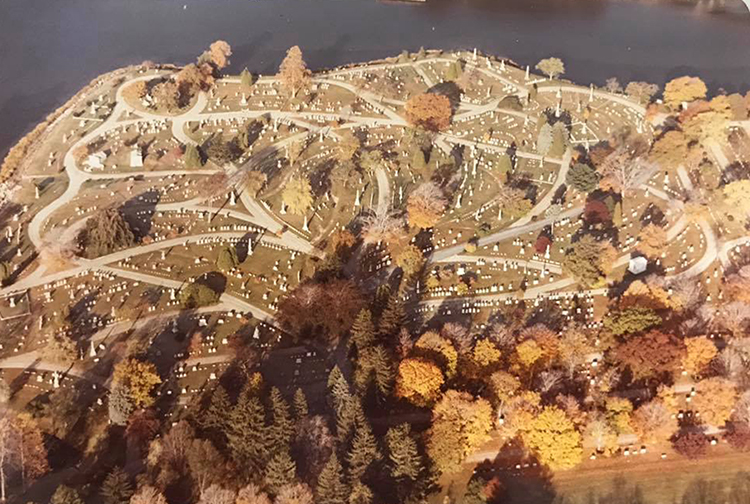
Elm Grove in the 1980s
N.B. Schubarth, a Providence, RI landscape architect, was hired and designed the cemetery in the shape of an Elm tree. Schubarth’s plans called for a principal venue, 20 ft. wide, named Elm, "commencing at the gate, winding along the outskirts of the grounds and returning again to the gate.” All other avenues measured 18 ft. wide, except for Cherry (16’) and Beech (10’). All paths were 6 ft. wide and a 2 ft. border was set off between avenues, paths, and lots to plant trees, shrubs and flowers. A one-foot space separated individual lots. A six-foot high fence of yellow pine pickets with stone posts enclosed the cemetery grounds. By vote of the trustees, the cemetery was open to the public from dawn to dusk.
On Tuesday, July 11, 1854, formal ceremonies dedicating the grounds of the Elm Grove Cemetery Association were held. Addresses by several clergymen marked the occasion, with music provided by the Mystic Cornet Band.
Gravesites at Elm Grove were 60 cents per sq. ft. for lots fronting on a carriage avenue; and 5 cents per sq. ft. for lots fronting on a footpath, and were sold on a non-discriminatory basis. A section of the cemetery was set-aside for the many families who wanted to be interred near loved ones in Elm Grove.
In addition to transacting association business, the trustees had the power to determine ornamentation of lots. Obelisks dominate Elm Grove's landscape. Many are simple monoliths, while others are topped with Grecian vases and urns, symbols of eternity and immortality.
Although many examples of Victorian cemetery motifs adorn its monuments, the elaborate funeral sculpture of the era in the shape of chairs, hats and books, escaped Elm Grove. The monuments erected on the lots of the first trustees and men who incorporated the cemetery established the style of the cemetery’s decor. Moderation seemed to be their rule of thumb.
The Victorian woman in flowing robes, a favorite subject of nineteenth century cemetery art, tops the monuments on the Benjamin Hoxie and Elihu Spicer lots. This motif is repeated in various forms throughout the cemetery. The branches of an enormous weeping copper beech tree, imported from Holland, gracefully drape the simple stones on the Greenman lot. An elaborate obelisk, topped with a winged child leaning on an urn, and flanked by pedestals holding draped urns, marks the Cottrell lot. The entire gravesite is bordered by a foot-high granite curbing.
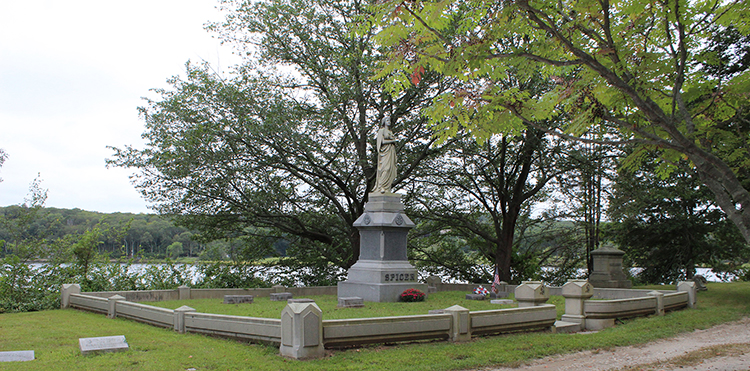
Although many rural cemeteries separated individual gravesites with wrought iron fences, Elm Grove's trustees banned fencing within the cemetery, feeling it detracted from the park-like atmosphere. Granite curbing, which added ornamentation without impeding strollers, was allowed with association approval. The exceptions to this rule are the lots of Elias Brown, which are set apart by a three-foot-high split rail fence of stone and cast iron.
Unlike other rural cemeteries, Elm Grove has only three mausoleums. The first, a receiving vault owned by the association, was erected in 1875 by the Smith Quarry Co. of Westerly, R.I. for $3,655.00. No longer used by the cemetery, the vault once stored bodies when burials were delayed.
The second and most elaborate monument in Elm Grove is the S.R. Packer mausoleum built in the early 1860s. Two Greek vases flank a sidewalk leading to the vault. Corinthian columns in heavy relief surmounted by a Roman arch highlight the crypt, and a Grecian urn tops the structure.

The third crypt in the cemetery belongs to the Copp family. Erected in the 1930s, the Vermont granite structure, with its Doric columns and bronze door, is a stark contrast to the ornate Packer vault.
Perpetual care began in 1875 when the Greenman family donated $300, the income from which was earmarked for upkeep of their lots. In ensuing years, many families left money to insure maintenance of their gravesites.
By the mid 1880s Elm Grove had nearly 2000 interments. In 1885 the trustees were directed to buy more acreage of land north of the cemetery entrance. In 1894, they expanded to the north and south, purchasing a section of land, known as the ropewalk, from the heirs of George Greenman for $810 and a tract from John Babcock for $1100. Further expansion to the north was made in the 1930s.
In the early 1890s funds to erect a granite entranceway in memory of Charles Henry Mallory were given by his widow, Mrs. Eunice Mallory, and their children. Preparations for building the archway began in 1892 with the construction of a heavy wall by G.W. Allyn along the eastern boundary of the cemetery. Lot owners and village residents were outraged when Allyn announced plans to remove the two enormous elms that marked the entrance to the cemetery to make room for the new stone gateway.

In an editorial entitled "Woodman, Spare That Tree," the Mystic Press condemned the demolition stating that "the erection of any work of man's hands, however artistic, would poorly atone for the undoing of a half century or more of Nature's grand handiwork."
Despite this public outcry, the elms came down, and The Westerly Granite Company, using several stonecutters imported from Italy, began construction of the memorial arch. The completed gateway, which still marks the entrance to the cemetery, spans 54 feet, is 32 feet high and measures 6 feet thick. The edifice consists of three arches, each with double wrought iron gates. The main archway, which serves as a driveway, is twenty feet wide by 22 ft. high. The main archway flanked by smaller arches, six feet wide and ten feet high, for pedestrians to use. Over the arches and just beneath the capstone is chiseled in relief the words "I am the Resurrection and the Life," and above the curve of the arch on either side the Greek letters Alpha and Omega.
The Mallory family left a trust fund whose interest still pays for the upkeep of the stone wall and the memorial arch as well as the opening and closing of the iron gateway each day.
Dedication ceremonies for the memorial arch were held August 7, 1895. Inclement weather forced the exercises indoors from the cemetery to the Methodist Church. Highlighting the ceremonies was an original hymn written for the occasion by the Rev. 0.0. Sherman and set to the tune America the Beautiful.
O Arch! So beautiful and strong,
The gift of faith and love;
We read thy words and sing
the song That angels sing above.
I am the resurrection life!
My loved ones they have rest,
Beyond the surging waves of strife
In mansions of the blest.
In 1897, a landing was built on the west side of the cemetery to accommodate visitors coming by boat. Marble benches were set among the trees and along the river, inviting people to roam through Elm Grove, enjoying its trees and viewing the magnificent flower beds, planted near the memorial arch.
Gracing the northwest end of the cemetery is Elm Grove's mortuary chapel, a gift from Mr. and Mrs. Edward S. Harkness, in memory of their parents and grandparents, Thomas Stillman Greenman and Charlotte Rogers Greenman. The marble used in its construction was quarried in Greece and furnished by James MacLaren's Sons of Brooklyn, N.Y. The stone was re-cut from unused marble brought to the U.S. to build the Dime Savings Bank of Brooklyn in 1911. John Thatcher and Son, of Brooklyn, with James Gamble Rogers, erected the chapel, architect.
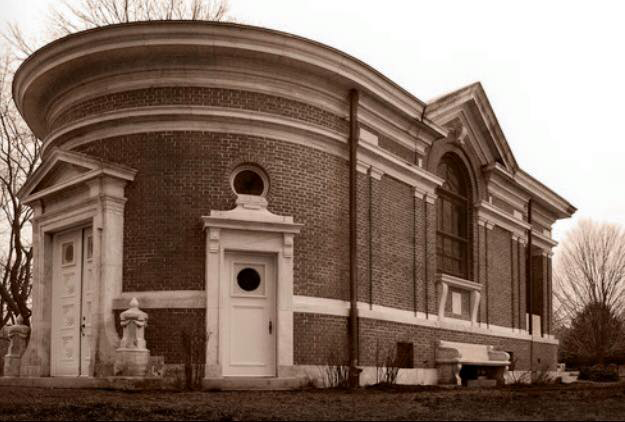
Although rarely used today, the brick and marble building has been the scene of many religious services including at least one wedding.
Mary Harkness and her sister, Miss Stillman, presided at the ceremony of laying the cornerstone for the chapel in September of 1911. Using a silver trowel presented to her by the trustees and inscribed with the date of the occasion, Mrs. Harkness sealed a box of memorabilia inside the cornerstone. Included in its contents were several U.S. stamps, a five dollar gold piece; silver, paper and half dollars, quarter, ten, five and three cent pieces; pennies from 1853 and 1911, pictures of the trustees and the superintendent, a program from the dedication of the memorial arch in 1895, weekly and daily papers, a brief history of the association; a silk flag presented by the Fanny Ledyard chapter D.A.R. along with that chapter's by-laws; and the names of the chapel's architect and builders.
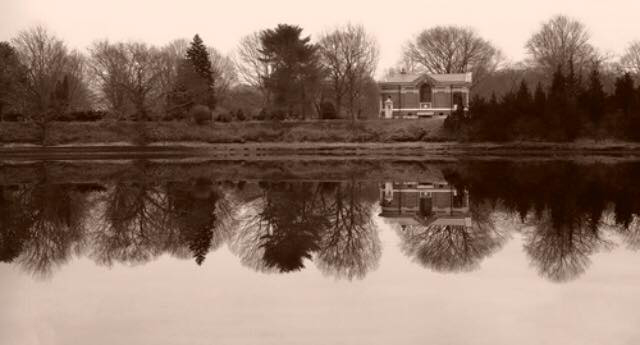
As Mrs. Harkness left the festivities that day, Henry Schroeder, grounds superintendent, presented her with a little rake she used when playing in the cemetery as a child with his children. Schroeder was the backbone of Elm Grove, serving as its groundskeeper for over 50 years, until his death in 1923. The trustees in many pages of the association’s minutes recorded Schroeder’s devotion, and hard work. A landscaper and horticulturist, Schroeder was responsible for many of the unusual trees and shrubbery within the cemetery walls, including the weeping copper beeches and weeping white birches. The longevity of Schroeder's landscaping is evident by the many ancient trees adorning the property. The only deterrent to his handiwork was the 1938 hurricane, which destroyed nearly half of the cemetery's trees.
The trustees showed their appreciation to Schroeder in many ways through the years. In 1891, they gave him cemetery lot 981 "for faithful service." He and his family are laid to rest on the site, overlooking Lily Pond and its four-tiered fountain erected in 1909 with funds donated by J.D. Crary of New York City, formerly of Mystic.
In 1905, H.R. Douglass of New London built the present superintendent’s house with plans drawn by Donnelly and Hazeltine. A barn was erected the following year. The former house, which was built in 1855 for David Price, the first superintendent, was sold to Walter G. Morgan, who moved it to its present location, directly across the street from the cemetery.
In 1916, the association presented Schroeder with a gold-headed ebony cane for 49 years of service. The following year the Board marked his 50th anniversary by bringing $100 in gold to the superintendent's house because he was too ill to attend the annual meeting.
Today, more than a century after its incorporation, the Elm Grove Cemetery Association still thrives, operating primarily with revenues from the sale of lots and foundations. Due to careful planning and expansion, the association has enough space for burials for the next 50 years. In 1979 an administrative building was added to the grounds and dedicated to another faithful employee, J.B. Stinson, who served as association treasurer for over 60 years, until his retirement in 1979.
In spite of encroaching development to its north and south and a busy interstate highway near by, Elm Grove still offers a beautiful park setting for those who care to wander through a piece of local history.
Marilyn J. Comrie
April 15, 1981
